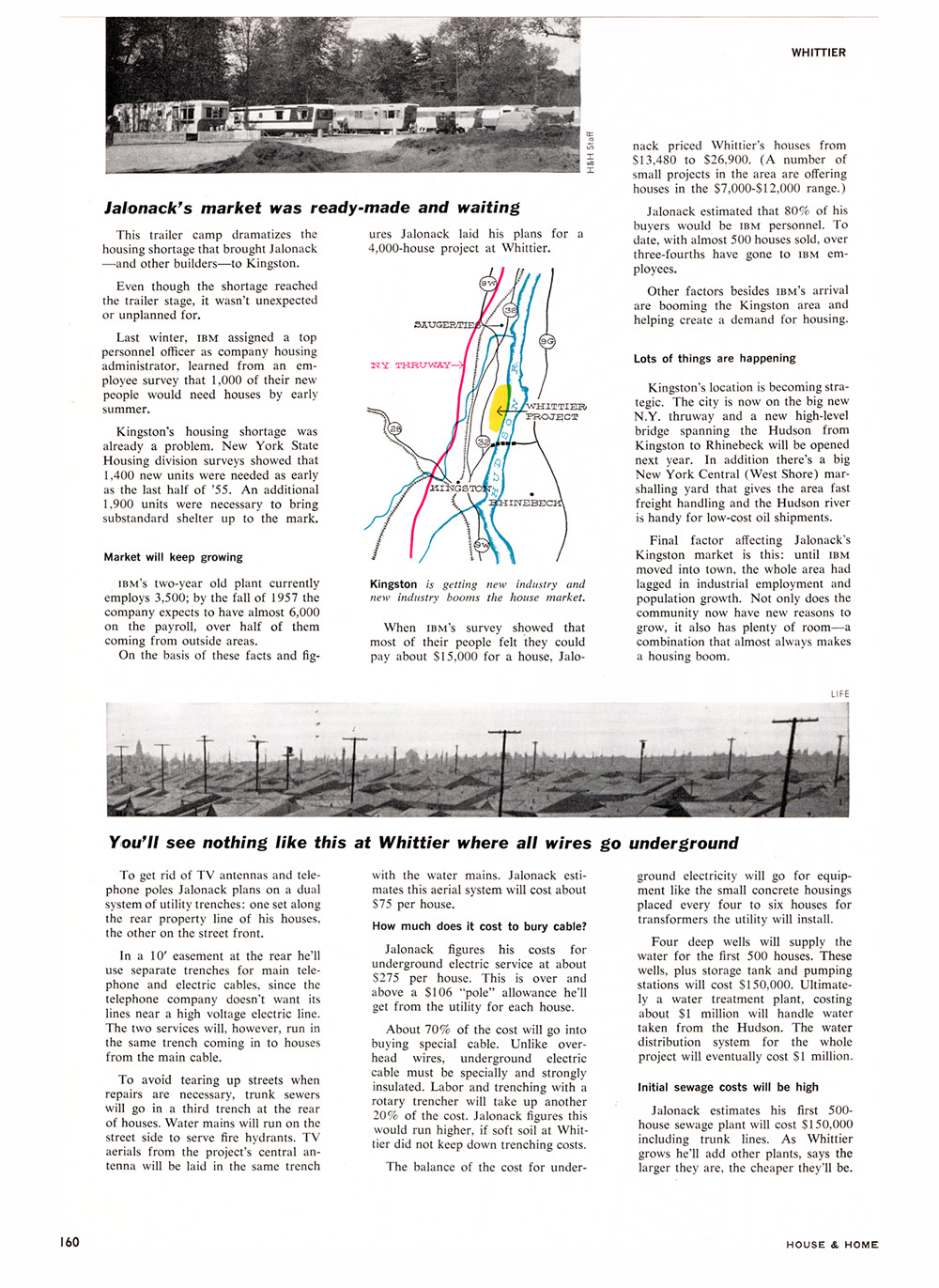


WHITTIER
This trailer camp dramatizes the housing shortage that brought Jalonack and other builder-”to Kingston.
Even though the shortage reached the trailer stage, it wasn't unexpected or unplanned for.
Last winter, ibm assigned a top personnel officer as company housing administrator, learned from an employee survey that 1,000 of their new people would need houses by early summer.
Kingston's housing shortage was already a problem. New York State Housing division surveys showed that 1,400 new units were needed as early as the last half of '55. An additional 1,900 units were necessary to bring substandard shelter up to the mark.
Market will keep growing
ibm's two-year old plant currently employs 3,500; by the fall of 1957 the company expects to have almost 6,000 on the payroll, over half of them coming from outside areas.
On the basis of these facts and fig
ures Jalonack laid his plans for a 4,000-house project at Whittier.
Kingston is getting new industry and new industry booms the house market.
When ibm's survey showed that most of their people felt they could pay about $15,000 for a house, Jalo
nack priced Whittier's houses from $13,480 to $26,900. (A number of small projects in the area are offering houses in the $7,000-$ 12,000 range.)
Jalonack estimated that 80% of his buyers would be ibm personnel. To date, with almost 500 houses sold, over three-fourths have gone to ibm employees.
Other factors besides ibm's arrival are booming the Kingston area and helping create a demand for housing.
Lots of things are happening
Kingston's location is becoming strategic. The city is now on the big new N.Y. thruway and a new high-level bridge spanning the Hudson from Kingston to Rhinebeck will be opened next year. In addition there's a big New York Central (West Shore) marshalling yard that gives the area fast freight handling and the Hudson river is handy for low-cost oil shipments.
Final factor affecting Jalonack's Kingston market is this: until ibm moved into town, the whole area had lagged in industrial employment and population growth. Not only does the community now have new reasons to grow, it also has plenty of room a combination that almost always makes a housing boom.
LIFE
You'll see nothing like this at Whittier where all wires go underground
To get rid of TV antennas and telephone poles Jalonack plans on a dual system of utility trenches: one set along the rear property line of his houses, the other on the street front.
In a 10' easement at the rear he'll use separate trenches for main telephone and electric cables, since the telephone company doesn't want its lines near a high voltage electric line. The two services will, however, run in the same trench coming in to houses from the main cable.
To avoid tearing up streets when repairs are necessary, trunk sewers will go in a third trench at the rear of houses. Water mains will run on the street side to serve fire hydrants. TV aerials from the project's central antenna will be laid in the same trench
with the water mains. Jalonack estimates this aerial system will cost about $75 per house.
How much does it cost to bury cable?
Jalonack figures his costs for underground electric service at about $275 per house. This is over and above a $106 "pole"¯ allowance he'll get from the utility for each house.
About 70% of the cost will go into buying special cable. Unlike overhead wires, underground electric cable must be specially and strongly insulated. Labor and trenching with a rotary trencher will take up another 20% of the cost. Jalonack figures this would run higher, if soft soil at Whittier did not keep down trenching costs.
The balance of the cost for under
ground electricity will go for equipment like the small concrete housings placed every four to six houses for transformers the utility will install.
Four deep wells will supply the water for the first 500 houses. These wells, plus storage tank and pumping stations will cost $150,000. Ultimately a water treatment plant, costing about $1 million will handle water taken from the Hudson. The water distribution system for the whole project will eventually cost $1 million.
Initial sewage costs will be high
Jalonack estimates his first 500-house sewage plant will cost $150,000 including trunk lines. As Whittier grows he'll add other plants, says the larger they are, the cheaper they'll be.